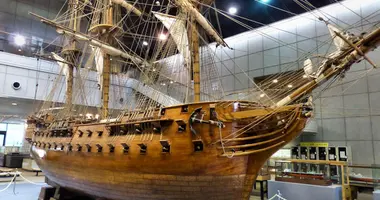Awajishima Museum
- Published on : 08/06/2019
- by : Japan Experience
- Youtube
Awajishima Museum is the largest museum on Awaji Island, located at the base of Sumoto Castle. It has displays devoted to the history and culture of Awaji.
Awajishima Museum 淡路文化史料館
 Awajishima History & Culture Museum in Sumoto
Awajishima History & Culture Museum in Sumoto
The Awajishima Museum is the biggest museum on Awaji Island and is devoted to history and culture.
It is located at the base of the hill on which stands the ruins of Sumoto Castle in the old part of Sumoto, the biggest town on the island. A part of the old moat still exists in front of the museum.
 Some of the floats used in Awaji Island's traditional festivals
Some of the floats used in Awaji Island's traditional festivals Display of Awaji Puppet Theater at Awajishima Museum
Display of Awaji Puppet Theater at Awajishima Museum
Exhibits
It is a pretty old-fashioned type of museum with standard types of displays. However, the museum is surprisingly large and has a wide range of exhibits including a large collection of materials relating to Awaji Ningyo Joruri, the Awaji Puppet Theater.
Many people come to Awaji to visit the Puppet Theater at the southern tip of the island where performances take place every day.
However, the theater only has a small display of materials about the art and history of Awaji Ningyo, but here at the museum there is quite a lot. There are also displays of some of the floats that historically took part in the island's festivals.
It is primarily a history museum, and the history goes way back into prehistory and includes various archaeological finds including bronze mirrors and a rare example of a dugout canoe.
Special emphasis is given to the rulers of Awaji, which was in ancient times a separate province but since the Edo Period was ruled from what is now Tokushima on Shikoku. There's plenty on Sumoto Castle, on the hill above the museum, which was the main castle on Awaji during the Edo Period.
 A model of Sumoto Castle, Awajishima Museum
A model of Sumoto Castle, Awajishima Museum
Tamao Naohara
Some displays cover mythology connected to Awaji, especially the ancient myth of the creation of the Japanese Islands by Izanagi and Izanami, as it is said that the first island created was Awaji itself.
The museum also covers folklore and folk history with the usual collections of traditional farming implements, crafts, and everyday objects. Being an island, the sea has been perhaps more important than farming and so there are also models of boats and old fishing equipment etc.
The final part of the museum is called the Tamao Naohara Memorial Museum of Art and is named after a painter who grew up in Sumoto.
On display are some of his paintings as well as paintings and artworks that he had collected. There are no particularly famous works, and the emphasis is on ink paintings, but the collection is interesting enough and better than some I have seen.
All the display information is in Japanese, but a pamphlet in English is available that contains an overview of the museum and details of some of the major exhibits.
 Folk art and materials from traditional Awaji Island life
Folk art and materials from traditional Awaji Island life
Access & Information
Awajishima Museum
1-chome -1-27 Yamate
Sumito-shi, Hyogo 656-0024
Tel: 0799 24 3331
Open from 9 am to 5 pm. Closed on Mondays.
Entry 400 yen for adults, 250 yen for HS students, 100 yen for younger children
The museum is a ten minute walk from Sumoto Bus Center which is reached by local buses from other parts of the island or by the express buses that run between Shin-Kobe or Sannomiya Station in Kobe and Tokushima city.
A ferry from Akashi runs regularly to the north of the island.
Awaji is easily reached from nearby Kobe, Himeji, Kyoto or Osaka.
 Some of the paintings from the collection of Tamao Naohara, a locally born artist
Some of the paintings from the collection of Tamao Naohara, a locally born artist
Accommodation in Awaji
Area Map
Nearby Places of Interest
Akashi Castle - built in 1619 to protect the approach to Osaka from the west.
Shimanami Kaido - 60 kilometer expressway that links the main island of Honshu with the island of Shikoku.
Maiko Park - a pleasant park with views of the Akashi Kaikyo Bridge and some historic residences.
World Peace Giant Kannon - once one of the largest statues in the world it is now virtually abandoned.
Yumebutai - designed by Tadao Ando includes a resort hotel, a conference center, a wedding chapel, an open air theater and a botanical museum.
Honpukuji - aka the Water Temple by Tadao Ando.
Awaji Puppet Theater - has daily performances of Awaji Ningyo Joruri.
Izanagi Jingu & Onokorojima Shrine - two important shrines connected with Japan's creation myth.
















